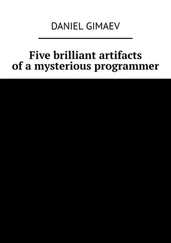Standard Template Library Programmer's Guide
Здесь есть возможность читать онлайн «Standard Template Library Programmer's Guide» весь текст электронной книги совершенно бесплатно (целиком полную версию без сокращений). В некоторых случаях можно слушать аудио, скачать через торрент в формате fb2 и присутствует краткое содержание. Жанр: Программирование, Справочники, на английском языке. Описание произведения, (предисловие) а так же отзывы посетителей доступны на портале библиотеки ЛибКат.
- Название:Standard Template Library Programmer's Guide
- Автор:
- Жанр:
- Год:неизвестен
- ISBN:нет данных
- Рейтинг книги:4 / 5. Голосов: 1
-
Избранное:Добавить в избранное
- Отзывы:
-
Ваша оценка:
- 80
- 1
- 2
- 3
- 4
- 5
Standard Template Library Programmer's Guide: краткое содержание, описание и аннотация
Предлагаем к чтению аннотацию, описание, краткое содержание или предисловие (зависит от того, что написал сам автор книги «Standard Template Library Programmer's Guide»). Если вы не нашли необходимую информацию о книге — напишите в комментариях, мы постараемся отыскать её.
Standard Template Library Programmer's Guide — читать онлайн бесплатно полную книгу (весь текст) целиком
Ниже представлен текст книги, разбитый по страницам. Система сохранения места последней прочитанной страницы, позволяет с удобством читать онлайн бесплатно книгу «Standard Template Library Programmer's Guide», без необходимости каждый раз заново искать на чём Вы остановились. Поставьте закладку, и сможете в любой момент перейти на страницу, на которой закончили чтение.
Интервал:
Закладка:
[3] Resizing does not invalidate iterators; however, it does not necessarily preserve the ordering relation between iterators. That is, if i and j are iterators that point into a Hashed Associative Container such that i comes immediately before j , then there is no guarantee that i will still come immediately before j after the container is resized. The only guarantee about about the ordering of elements is the contiguous storage invariant: elements with the same key are always adjacent to each other.
Associative Container, Sorted Associative Container, Unique Hashed Associative Container, Multiple Hashed Associative Container
Hash Function
Categories: containers, functors
Component type: concept
A Hash Function is a Unary Function that is used by Hashed Associative Containers: it maps its argument to a result of type size_t . A Hash Function must be deterministic and stateless. That is, the return value must depend only on the argument, and equal arguments must yield equal results.
The performance of a Hashed Associative Container depends crucially on its hash function. It is important for a Hash Function to minimize collisions, where a collision is defined as two different arguments that hash to the same value. It is also important that the distribution of hash values be uniform; that is, the probability that a Hash Function returns any particular value of type size_t should be roughly the same as the probability that it returns any other value. [1]
Unary Function
| Result type | The type returned when the Hash Function is called. The result type must be size_t . |
None, except for those described in the Unary Function requirements.
| Deterministic function | The return value depends only on the argument, as opposed to the past history of the Hash Function object. The return value is always the same whenever the argument is the same. |
• hash
[1] Note that both of these requirements make sense only in the context of some specific distribution of input values. To take a simple example, suppose that the values being hashed are the six strings "aardvark", "trombone", "history", "diamond", "forthright", and "solitude". In this case, one reasonable (and efficient) hash function would simply be the first character of each string. On the other hand, suppose that the values being hashed are "aaa0001", "aaa0010", "aaa0011", "aaa0100", "aaa0101", and "aaa0110". In that case, a different hash function would be more appropriate. This is why Hashed Associative Containers are parameterized by the hash function: no one hash function is best for all applications.
Hashed Associative Container, hash
Unique Associative Container
Category: containers
Component type: concept
A Unique Associative Container is an Associative Container with the property that each key in the container is unique: no two elements in a Unique Associative Container have the same key.
Associative Container
None, except for those defined by Associative Container.
XA type that is a model of Unique Associative Container
aObject of type X
tObject of type X::value_type
kObject of type X::key_type
p, qObject of type X::iterator
In addition to the expressions defined in Associative Container, the following expressions must be valid.
| Name | Expression | Type requirements | Return type |
|---|---|---|---|
| Range constructor | X(i, j) X a(i, j); |
i and j are Input Iterators whose value type is convertible to T [1] | |
| Insert element | a.insert(t) |
pair |
|
| Insert range | a.insert(i, j) |
i and j are Input Iterators whose value type is convertible to X::value_type . [1] | void |
| Count | a.count(k) |
size_type |
| Name | Expression | Precondition | Semantics | Postcondition |
|---|---|---|---|---|
| Range constructor | X(i, j) X a(i, j); |
[i,j) is a valid range. | Creates an associative container that contains all of the elements in the range [i,j) that have unique keys. | size() is less than or equal to the distance from i to j . |
| Insert element | a.insert(t) |
Inserts t into a if and only if a does not already contain an element whose key is the same as the key of t . The return value is a pair P . P.first is an iterator pointing to the element whose key is the same as the key of t . P.second is a bool : it is true if t was actually inserted into a , and false if t was not inserted into a , i.e. if a already contained an element with the same key as t . | P.first is a dereferenceable iterator. *(P.first) has the same key as t . The size of a is incremented by 1 if and only if P.second is true . | |
| Insert range | a.insert(i, j) |
[i, j) is a valid range. | Equivalent to a.insert(t) for each object t that is pointed to by an iterator in the range [i, j) . Each element is inserted into a if and only if a does not already contain an element with the same key. | The size of a is incremented by at most j – i . |
| Count | a.count(k) |
Returns the number of elements in a whose keys are the same as k . | The return value is either 0 or 1 . |
Average complexity for insert element is at most logarithmic.
Average complexity for insert range is at most O(N * log(size() + N)) , where N is j – i .
| Uniqueness | No two elements have the same key. Equivalently, this means that for every object k of type key_type , a.count(k) returns either 0 or 1 . |
• set
• map
• hash_set
• hash_map
[1] At present (early 1998), not all compilers support "member templates". If your compiler supports member templates then i and j may be of any type that conforms to the Input Iterator requirements. If your compiler does not yet support member templates, however, then i and j must be of type const T* or of type X::const_iterator .
Читать дальшеИнтервал:
Закладка:
Похожие книги на «Standard Template Library Programmer's Guide»
Представляем Вашему вниманию похожие книги на «Standard Template Library Programmer's Guide» списком для выбора. Мы отобрали схожую по названию и смыслу литературу в надежде предоставить читателям больше вариантов отыскать новые, интересные, ещё непрочитанные произведения.
Обсуждение, отзывы о книге «Standard Template Library Programmer's Guide» и просто собственные мнения читателей. Оставьте ваши комментарии, напишите, что Вы думаете о произведении, его смысле или главных героях. Укажите что конкретно понравилось, а что нет, и почему Вы так считаете.











